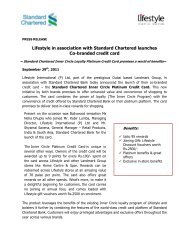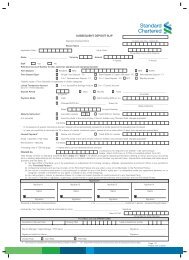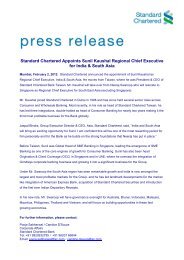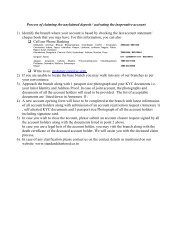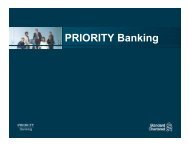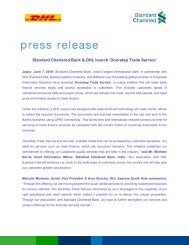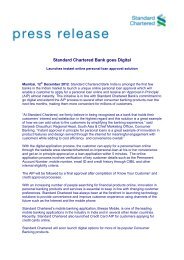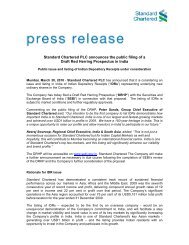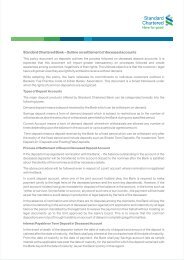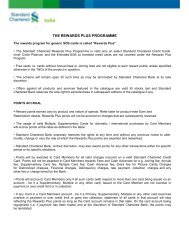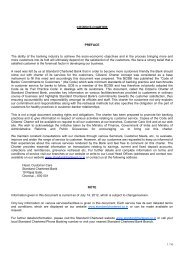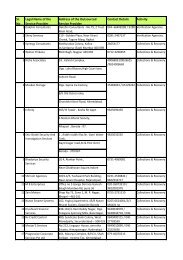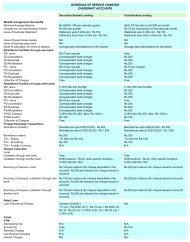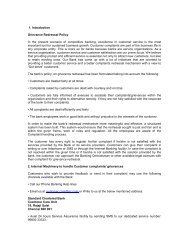March 12 - Standard Chartered Bank
March 12 - Standard Chartered Bank
March 12 - Standard Chartered Bank
Create successful ePaper yourself
Turn your PDF publications into a flip-book with our unique Google optimized e-Paper software.
Risk review and disclosures under Basel II Framework for the year ended 31 <strong>March</strong> 20<strong>12</strong><br />
• The First Line of Defence is that all employees are required to ensure the effective management of risks<br />
within the scope of their direct organisational responsibilities, which includes material risks are identified,<br />
assessed, mitigated, monitored and reported; compliance with internal policies, procedures, limits, other<br />
risk control requirements and external laws/regulations are implemented and complied with; identify<br />
activities that should be a focus for independent control monitoring; propose control enhancements to<br />
ensure that any known risks are controlled within acceptable boundaries and to consistent standards; align<br />
business/functional strategy with risk appetite and seek to optimise the risk-return profile of the business;<br />
and set the right tone for the risk management culture of the team in internal communications and<br />
performance objectives.<br />
• The Second Line of Defence comprises the Risk Control Owners (“RCOs”), supported by their respective<br />
functional organisation at each applicable layer of the organisation: Group, Business and Country. RCOs are<br />
responsible for ensuring that the residual risks within the scope of their responsibilities remain within<br />
appetite. There are three central aspects to discharging the responsibility: the identification of material<br />
risks; maintaining an effective control environment; and the understanding and accepting levels of residual<br />
risk. The RCO must also engage whatever skills and experience are necessary, including working with other<br />
RCOs to ensure comprehensive risk identification and effective control. The second line is independent of<br />
the origination, trading and sales functions to ensure that the necessary balance and perspective is brought<br />
to risk/return decisions. This is particularly important given that revenues are recognised immediately while<br />
losses arising from risk positions only manifest themselves over time. The Second Line has the authority to<br />
challenge, constrain and, if required, stop business activities where risks are not aligned with control<br />
requirements or risk appetite. The scope of a RCO’s responsibilities is defined by a given Risk Type and the<br />
risk management processes which relate to that Risk Type. The application of laws, regulations, rules and<br />
other codes of practice that the <strong>Bank</strong> is subject to are the responsibility of the RCO within whose scope of<br />
activities they apply. Given the nature of OR, there are multiple RCO’s. Risk control ownership for OR is<br />
shared between the OR function which has overall responsibility for OR and the specialist OR control owner.<br />
Each specialist OR control owner has responsibility for all OR which arise from a given set of specialist<br />
activities rather than a single operational risk type.<br />
• The Third Line of Defence is GIA. It is an independent function whose role is defined and overseen by the<br />
Board Audit Committee/MANCO and is set out in the Group’s Internal Audit Charter. GIA provides<br />
independent assurance of the effectiveness of management’s control of its own business activities (the first<br />
line of defence) and of the processes maintained by the risk control functions (the second line of defence).<br />
As a result, GIA provides assurance that the overall system of control effectiveness is working as required<br />
within the RMF. The findings from GIA’s audits are reported to all relevant management and governance<br />
bodies accountable line managers, relevant oversight function or committee and sub-committees of the<br />
MANCO/Board. GIA has no responsibility for any of the activities it examines. It has unrestricted access to<br />
all records, information, personnel and physical properties of the <strong>Bank</strong> that are relevant to the audits and<br />
reviews being undertaken.<br />
31



